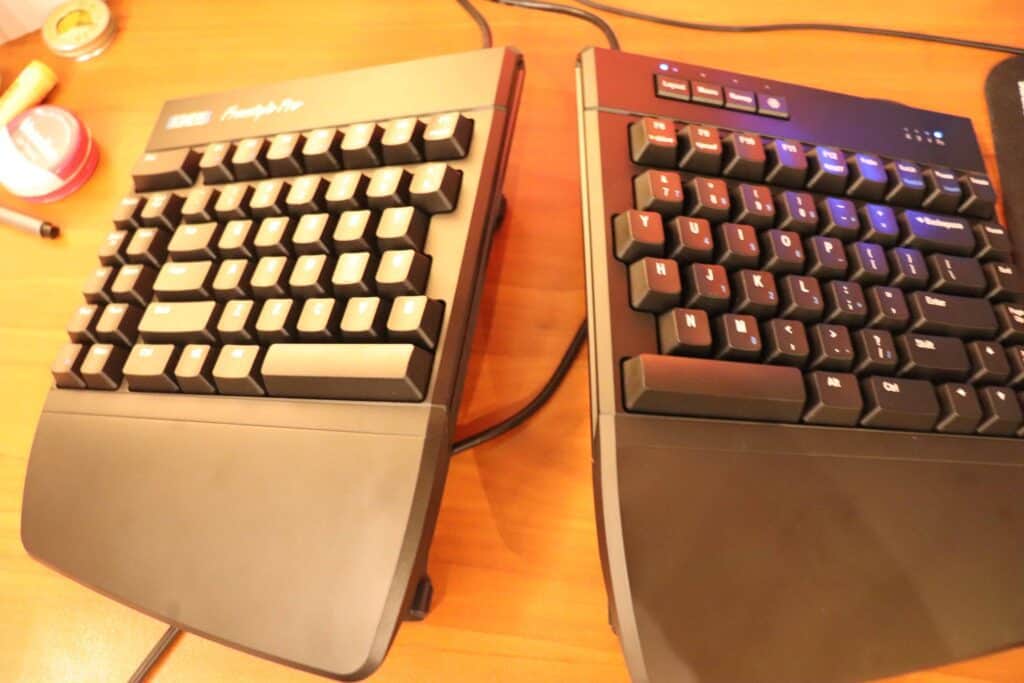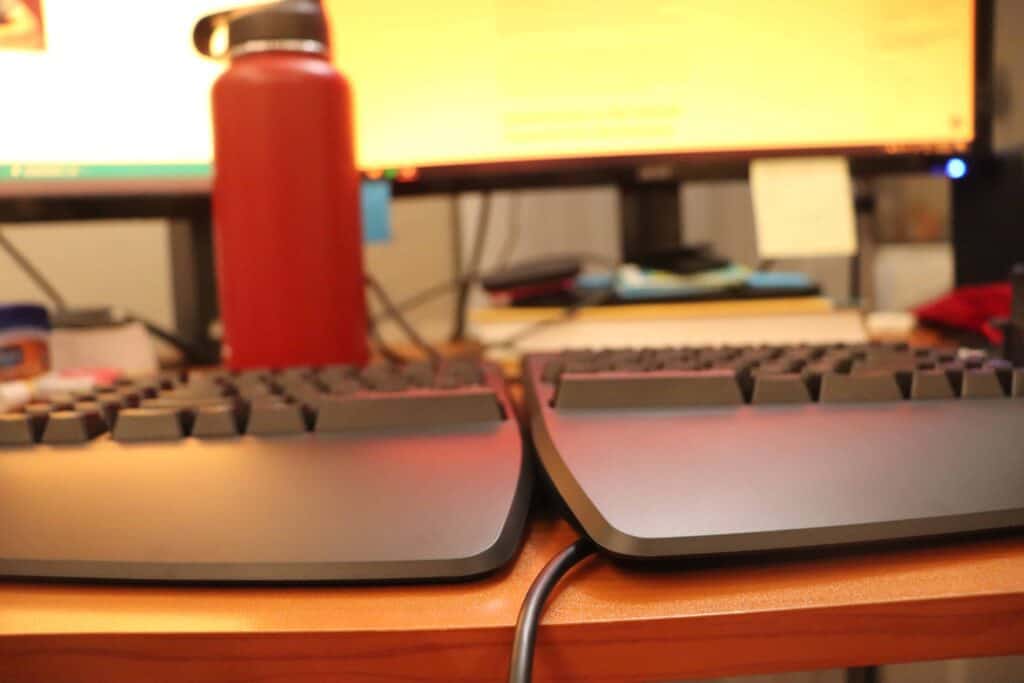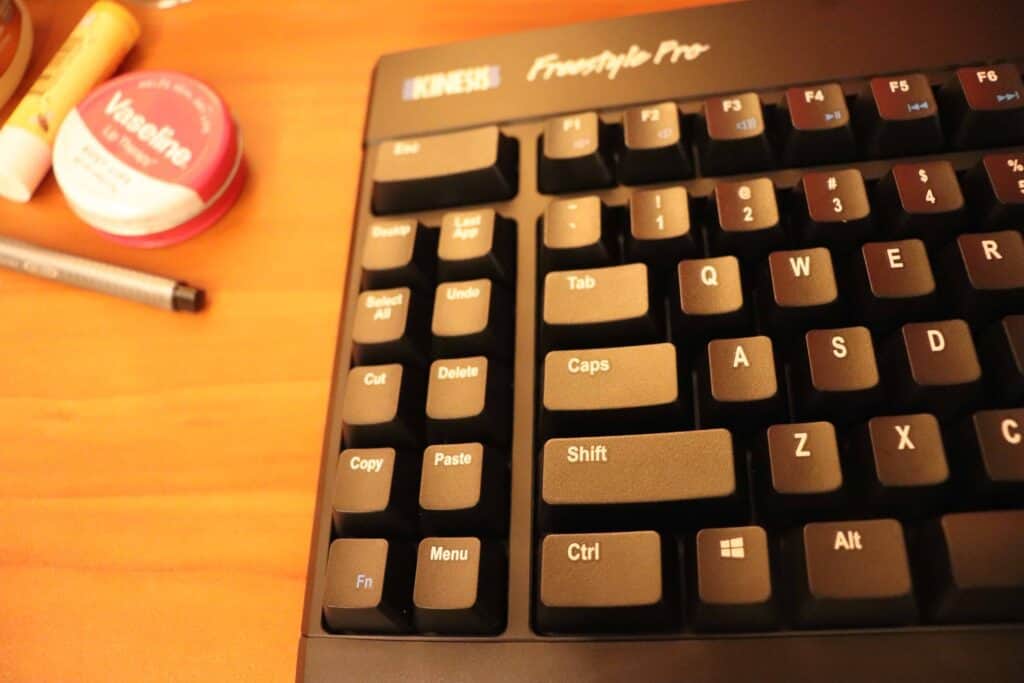First thing first: I typed for over ten hours on this keyboard with a typing speed of about 20wpm and pressing backspace every word to type out this review for you guys. I hope you really appreciate all the effort we put into our reviews.
Introduction to the Kinesis Freestyle Pro Mechanical Keyboard

The Kinesis Freestyle Pro is a mechanical keyboard made by Kinesis, and it is a split keyboard. It comes with Cherry MX Brown switches. You can also purchase the Quiet version of this keyboard for the same price with Cherry MX Red switches. It is meant to be an ergonomic keyboard with many ergonomic features such as splitting, tenting, palm rests, mechanical switches, and multiple keyboard layouts.
The keyboard lets you switch instantly between Windows, Mac, and Dvorak layouts. It’s also fully programmable using the Kinesis firmware to switch to whatever layout you need. It comes with Windows and Mac keycaps for the control, option, command, windows, and alt keys. It also has onboard shortcuts that do not require installation of the firmware.
Let’s talk about price. It’s expensive. At full price on the Kinesis website, this keyboard is $179. But that’s not all. If you also want the tenting kit and palm rests that make this keyboard ergonomic, you’ll also have to purchase the additional VIP PRO3 kit, which costs and additional $40. So, the total of this keyboard with all the bells and whistles would be $219.
Currently, on Amazon, this keyboard by itself is currently selling for $169, which is $10 cheaper than on the Kinesis website. However, on Amazon, it doesn’t come with the 60-day guarantee or the 2-year warranty. It is currently rated 4.5 stars on Amazon with a total of 37 reviews.
It has a keyboard layout very similar to a 65% keyboard except they have extra keys such as the entire function row on its large forehead. It also has 8 macro keys that are currently programmed to productivity keys. A benefit of this layout is that the keyboard has all the arrow keys as well as buttons such as Home, PgUp, PgDn, End, and Pause and Delete. There are no dedicated media keys, but they do exist on a second layer on the Function row.
Design

Flat typing slope
When your first take this keyboard straight out of the box, it doesn’t come with a tenting kit. It has no natural slope to the typing angle unlike keyboards such as the Dierya DK61 or the Anne Pro 2. This is meant to prevent wrist extension while typing. You are supposed to float your hands over the keyboard while typing.
20” Length Cord in Between Keyboards
The cord that connects the two halves can extend to as much as 20 inches. The extra cord length is hidden within the bottom of the keyboard, so it doesn’t clutter up your desk space. If you look at the bottom of the left side, there is a slide out lid that will reveal the extra cord.
The minimum length is at 12 inches. Unfortunately for me, there is still excess cord between the halves. When we talked about shoulder external rotation within the original ergonomic keyboard article, we found out that split keyboards allowed you to increase the distance between your hands, encouraging an open chest rather than a closed one, preventing a tight chest and shoulders.
Tenting Kit
The tenting kit costs extra, but without this kit, it would probably not be worth buying this keyboard. The accessories that come inside the kit are the palm supports and the tenting adjustments, which let you have three different slope settings: 5, 10, and 15 degrees.
The Size of the Keyboard
The keyboard is quite big. It has a full function row at the top, arrow keys, call of the keys on a tenkeyless layout basically, but in a different design. The far-left side has eight macro keys that you can change because this keyboard is 100% programmable.
Different Layouts
This keyboard offers three different layouts with a simple way to change between them. The first two are obvious: Windows and Mac. The last one is less known, and that is Dvorak. We’ve recently wrote an article comparing Colemak and Dvorak, so if you’re interested in more, then click the link to Dvorak.
Dvorak was created in 1936 and is the 2nd most popular keyboard layout after QWERTY for the English language. Its purpose is to make typing more efficient by reducing finger fatigue, lessening finger motion, reducing errors, and muscle fatigue.
It places the most common keys in the home row and the least common keys on the bottom row, allowing the base position to be used more often.
The Upsides: Why This Could Save Your Body
Ergonomics is an important thing to me due to my background in occupational therapy. It’s also very close to home because we do so much typing on a regular basis and do suffer from overuse injuries or strains from typing in an uncomfortable position.
We’ve touched on many of these topics in our article on ergonomic keyboards, but we’ll do a quick rundown here. Having the ability to split up your keyboard lets you type with shoulder external rotation or neutral. The problem with being constantly in internal rotation is that your front shoulder and chest muscles get shortened over time.
If you have wide shoulders, this keyboard can be spread up to 20 inches and will work for anybody. Another benefit is being able to tent the keyboard. When you type on a typical keyboard, your forearms are in constant pronation. Over time, this also encourages shoulder internal rotation as well. By tenting your keyboard to up to 15 degrees, you are facilitating the opening of your chest and shoulder position. It also encourages a neutral wrist position with the palm rest and ability to angle the keyboard to your liking.
And of course, there’s a benefit to typing on mechanical keyboards. Using individual switches that are easy to press lets you use less pressure to press the keys than if you were typing on a rubber dome membrane keyboard. Unfortunately, the switches are not hot-swappable, but they do offer Cherry MX Browns or Reds. These switches have a total distance of 4.0mm, a actuation distance of 2.0mm, and an actuation force of 45g each.
First Impressions
Decreased Typing Speed due to the layout of the keyboard
I could type at a rate of about 18 words per minute due to my typing style. I do not type by keeping my fingers on the home row keys. I also never use my left shift keys.
Currently, I am writing this review on the Freestyle Pro and it is going slow. I basically must change the way I type completely. It’s like learning how to type all over again.
However, despite this difficulty, I find this keyboard very ergonomic. It’s making me feel for those bumps that are right under the F and J keys. Almost like learning a new layout such as Dvorak. It might be easier to switch to a split keyboard if the layout is ortholinear because the staggered keys are difficult to remember the exact distance between each key.
So far, I’m noticing less stretching of my fingers when I’m typing despite all the typos. It pretty much forces you to keep returning to the home row keys or else you will lose your spot on the keyboard.
I’m also not sure where to put my mouse so that it’s not too far away. I just realized I never use my pinky finger when I type regularly, so there is a little bit of fatigue. Keep that mind if you do the same.
The cool features that are dedicated to productivity
On the far left of the keyboard, there are productivity macros. It has 10 additional keys on the left side of the keyboard, which makes the Escape button big.
Let’s talk through each of the macros. The first one is the Desktop button. Alright, the only function I can think of for this one is if you are doing something inappropriate in the workplace, and suddenly your boss walks in, and you press this button, which hides everything open and reveals only your desktop.
Just kidding, it’s probably great if you want a clear screen and want to start messing around with your open windows. To be honest, although the idea behind the macro keys are really cool, I can never see myself pressing them because I would have to take my left hand off the keyboard.
Okay, onto the next one, the Last App key. Pressing this key allows you to jump back to the previous application you had open. I can see this being really convenient if you are working on video editing or writing blogs and opening another window to do research.
The next one is Select All. We all know what this does. This would probably be convenient for word processing or doing office work. To be honest, I’d rather press Ctrl+A. In addition to Select All, the keyboard also offers the following keys: Undo, Cut, Delete, Copy, Paste, and Menu. It is very great to use those keys in combination with the mouse to do video editing or photo work. I actually found myself using the Last App button instead of reaching to use my mouse to use the internet for a quick Google search and then switch back to Microsoft Word to continue typing about the topic.
The Numlock Feature
But, wait there’s no number pad though. You’re right. The right side of the keyboard has an extra layer that simulates a number pad when you turn Numlock on.
This is very convenient for number entry, however, I have yet to use this feature at all. Keep in mind that I do a lot of typing, but almost no number entry.
SmartSet Programming Engine

This program allows you to completely customize the keyboard’s layout without installing any software. This is in the keyboard itself, and the keyboard has up to 4MB flash memory. You can record macros of up to 300 characters long and choose different playback speeds.
If you prefer to use a graphical interface, you can launch the SmartSet App from your keyboard. Maybe I didn’t have the keyboard connected properly but I could not get the App to open up at all.
My Biggest Complaint: Took Some Time to Get Used To
One thing that I keep noticing is that when I go to press Ctrl+ something, I’ll always keeping going to the macro keys. It does take some time for your fingers to figure this keyboard out. For me, the most difficult part was getting my fingers used to where the keys were in relation to the split. I type weirdly and I jump around the keyboard a lot, so keeping them on each side was a bit difficult at first.
After a few hours of typing with the keyboard, it started feeling natural. I am impressed about my ability to adapt to such a different layout, and now I must use the left shift key, which is weird feeling as well.
For anyone who types using the home row keys, meaning you will always return to it after extending your fingers to type far away letters, it will be quicker for you to adapt to this kind of keyboard. It is not impossible for others to adapt though. The first hour or two, I was really frustrated and typed at a speed of about 15 words per minute. It was extremely frustrating compared to my usual 100+ words per minutes. After learning where the keys were, the speed quickly went up, although keys such as comma, period, apostrophe, and numbers are difficult.
Second Complaint: Why is it so big?
The ergonomic aspect of this keyboard is nice, but I think that it does have too many keys. I understand that it was meant for someone working in an office where they type a lot and need the productivity keys and the function keys, but it just seems like too much to have on your table.
This keyboard could’ve been made much smaller. The palm rests are huge and almost double the size of my hands. Each side of the keyboard can fit four of my hands…The forehead is very large and extra with the branding on the left top side.
Third Complaint: The Stabilizers
The stabilizers on this keyboard is especially rattly, especially the right shift key. It wouldn’t register for me sometimes since it clicked all funny when clicked from the far-left side.
I also occasionally find myself pressing Ctrl instead of Shift due to the placement of the keys. It is a regular layout, so nothing weird there, but I just wasn’t used to typing on a tented keyboard.
Summary
In conclusion, it’s the end of the review, and I type a little faster. It’s definitely possible to switch from a regular keyboard to a split staggered keyboard, but your productivity will drop for a couple of days while you sit there screaming every time you make a typo typing something you could breeze through a few days ago.
Despite all of that, I really enjoy this keyboard. For me, my hands are too small and feel uncomfortable and slight discomfort and fatigue typing on this keyboard for too long. It almost puts my fingers in an abnormal position. Perhaps with the cushioned wrist pad, my wrist will be in a better position. Due to my inability to jump around keys on this keyboard, it’s really fatiguing for my smaller fingers, especially the pinky finger.
So it doesn’t work for me, but it works great for my husband. He almost had no adaptation period because he does type on the home row. He also has big hands, which helps on a big keyboard.
This is a difficult decision to make, but I do not think I would recommend this keyboard. It is a great idea, but the execution of it is not the best. I’ve tried typing on keyboards such as the ErgoDox, MiniDox, Iris, Quefrequency split keyboards and have enjoyed those typing experiences much more due to how small the keyboards themselves were. They also did not have extra keys that I could accidentally press.
Another thing that I didn’t go into much was little finger fatigue. Reaching far with my pinky fingers to type Enter, Backspace, and both Shift buttons was very tiring.
However, Kinesis does offer a 60-day guarantee, so if you’re not like me (typing style or hand size), I would recommend you go out and try it. Another reason I don’t recommend it is because of the price tag. The keyboard by itself isn’t very ergonomic without buying the tenting kit. That means to get all the benefits, the total cost would be about $220, and they charge another $20 for shipping. Returns are paid for by you, so keep that in mind too.
In the end, I do plan on returning this keyboard. It’s not what I expected, and the price is too crazy for me to keep it and type uncomfortably. I’m moving closer to building my own ergonomic keyboard such as the Iris or the Quefrequency by Keeb.io.
